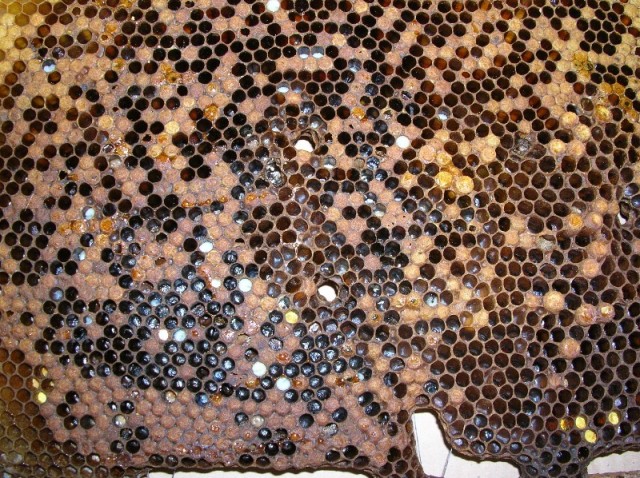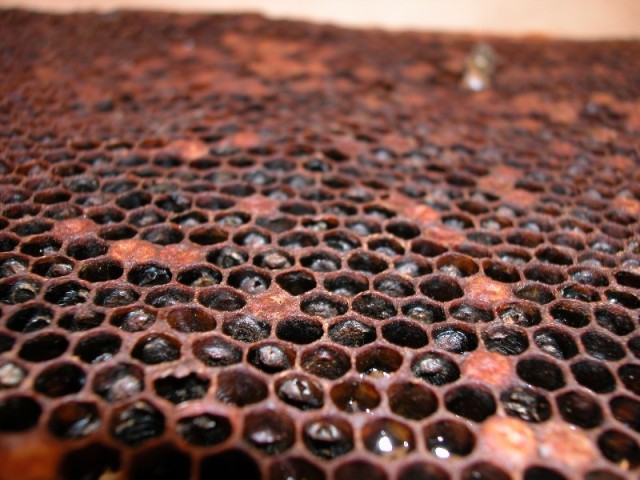A 2nd revision post for the British Beekeeping Association’s Module 3 Honey bee Pests, Diseases and Poisoning exam, which I plan to take in March. This year I’m doing the correspondence course, so I have a tutor who will set me papers and give me comments on my answers. Continuing my attempt at the first paper set.
B1. a) draw up a table of the similarities and differences in the signs of EFB and AFB
Similarities
|
|
|
|
Differences
|
|
|
b) how is a hive of bees infected with AFB or severe EFB dealt with by a Bee Diseases Inspector
The colonies will be destroyed by the inspector. The entrances will be reduced as soon as disease is confirmed. The bees are killed, and then burned together with the combs in a deep pit. The hive boxes can be sterilised by thoroughly scorching with a blow torch. This is done automatically in the case of AFB diagnosis, and in the case of EFB will be carried out if the colony is too small for other treatment methods or is too heavily infected to respond to treatment.
c) if the colony has only a mild EFB infection how will it be treated
In the case of mild EFB infection two treatments are possible – the shook-swarm husbandry technique, or treating with the antibiotic oxytetracycline (OTC, as the formulation Terramycin®)
Shook-swarm
I have a blog post explaining how a shook-swarm works, ‘A successful shook swarming‘. Basically your bees are shaken onto new foundation frames and all the old brood comb burned. They’re fed sugar syrup so they can draw out new comb quickly. The old EFB bacteria are destroyed this way and it’s also a helpful non-chemical anti-varroa treatment because of the short break in the queen laying.
Antibiotic treatment with oxytetracycline (OTC)
In my previous revision post I briefly covered some of the pitfalls of using antibiotic treatment for AFB & EFB (particularly if you begin using it as a preventative measure).
The National Bee Unit’s own data from trials shows that the shook swarm technique is more successful than OTC for the control of EFB in England and Wales. From the Beebase EFB page info:
“In the Spring following treatment, shaken colonies were three times less likely to test positive for M. plutonius. This finding appears logical since OTC treatment does not remove the etiological agent present in the hive. In contrast, the Shook swarm method provides the bees with M. plutonius-free material. In addition, OTC treated colonies were five times more likely to show recurrence of EFB the following year than Shook swarm treated colonies. A full copy of the project report is also available.”
If you had bed bugs, you wouldn’t just treat yourself against the little buggers, you’d treat your sheets too. Comb is the bees’ home, where they eat, sleep and produce young – they thrive on fresh new comb, just as it’s a healthy pleasure for us to slip into clean sheets at night.
Based on the data, my preference would be to use the shook-swarm technique rather than OTC antibiotics. In the field, your inspector will advise you on the best course of action based on the level of infection and time of year. In the unlikely event that you discovered in the depths of winter that EFB was present, January would not be a practical time to do a shook-swarm.
d) explain the life cycle of AFB and EFB and how they develop within the larvae and within the colony
EFB:
A (e)arly brood disease caused by the bacterium Melissococcus plutonius. It enters young larva through contaminated brood food and multiplies rapidly within the gut of the larva, competing with it for food. If a nectar flow is on and enough nurse bees are present to ensure a larvae is well-fed, a larva infected with EFB bacteria can survive – otherwise it is likely to die of starvation.
Unfortunately, some of the EFB infected larvae surviving to the sealed stage actually helps spread the disease. This is because when the cell is sealed the larva voids its gut prior to pupation, and does not fully cover the faeces with its cocoon. After it hatches out, the nurse bees cleaning the cell will pick up Melissococcus plutonius bacteria and pass them on to the next larvae they feed. Whereas when unsealed infected larvae die and are removed by the bees, the bacteria inside them are enclosed in a double layer within the gut and the outer exoskeleton.
AFB:
An (a)fter capping, late brood disease caused by the spore-forming bacterium Paenibacillus larvae. First, young larvae less than 2.5 days old become infected by Paenibacillus spores present in their food – older larvae are not susceptible. The spores germinate into a rod-shaped bacterial cell vegetative stage soon after they enter the larval gut and continue to multiply until the developing larvae dies.
Death typically occurs after the cell has been capped, usually during the last two days of the larval stage or the first two days of the pupal stage. The dead larvae gradually dry up until forming dark brittle scales within a month or so. Each scale contains as many as 100 million infectious AFB spores and is very difficult for either bees or beekeepers to remove from the cell – meaning that it can infect further young larvae. These spores can remain viable for decades in combs and honey.
e) give a detailed account of the ways they are spread from one colony to another
- Robbing – never leave comb or honey outside for the bees to clean up, as this encourages robbing
- Drifting – arrange your colonies in a way that discourages drifting. I have a Module 1 revision post which suggests some techniques for this.
- The beekeeper moving brood comb between colonies – always check for signs of brood disease first.
- Using old comb for several years. Preferably all brood comb should be changed annually using a shook-swarm or Bailey comb exchange technique and the old comb burned.
- Leaving dirty wax or comb around in the apiary.
- Buying in old equipment – never buy old combs and sterilise any second hand hives by scorching them with a blow torch before use.
- Bringing in unknown bees into an apiary, for instance a captured swarm or bees from another beekeeper. Quarantine new colonies for a few weeks first to make sure they are disease free before moving them into the apiary.
- Dead hives can be a source of infection. If you find a dead colony of bees, seal the hive to prevent the remaining stores being robbed out, before examining the brood combs for signs of disease. Burn up the old comb after examination.
You can find more tips on good hygiene and comb replacement techniques in my Module 1 ‘Good apiary hygiene‘ revision post.

Inspect brood comb regularly for brood disease. Courtesy The Food and Environment Research Agency (Fera), Crown Copyright.
f) give a detailed account of the use of lateral flow devices to diagnose foulbrood.
Information from FERA ‘Foul brood diseases of honey bees’ leaflet: “The routine diagnostic method used by the NBU to confirm the presence of foul brood is a field kit called a lateral flow device (or LFD). The term lateral flow refers to the suspect larval material flowing horizontally across the kit membrane into which specific antibodies have been incorporated. The kits were specifically developed to confirm foul brood and work on the same principles as a human pregnancy test. There are two kits in use and each is specific for the foul brood disease in question.”
The principle of the LFD relies upon the capture of target bacterium between an antibody test line. Two blue lines will be displayed in the case of positive detection and a single line for a negative result.
One larvae at a time should be shaken for twenty seconds in the testing fluid, which contains a number of ball bearings to make sure the larvae is broken up, then a pipette is used to extract some of the liquid and place a couple of drops on the yellow testing device. After approximately three minutes, either one or two blue lines appear. One line is the control which should appear quite quickly, if it does not, the kit is defective.
Believe it or not this is only two thirds of the first paper completed!
References:
- A Field Guide to Honey Bees and Their Maladies, Penn State College of Agricultural Sciences (2011) – recommended to me by another blog, this is so helpful and available as a free pdf download too.
- Guide to Bees & Honey, Ted Hooper (2010)
- Keeping Healthy Honey Bees, David Aston & Sally Bucknall, Northern Bee Books (2010)
- National Bee Unit Beebase website
- What are the signs of EFB, Di Drinkwater (2016)




I’m wondering whether a thymol treatment a few days after a shook swarm would further reduce the varroa population. If you do it too soon, the bees might abscond!
LikeLike
Interesting. That would really get numbers down.
LikeLike
The idea of beekeeping is more appealing than the reality. But I should know that . . . everything is more work than one imagines, and everything has its lows in addition to the highs.
It must be devastating to have to destroy a hive.
LikeLike
I think the same thing about your photography skills. I’ve never lost a hive yet, and really hope my current one makes it through the winter as they’re amazingly gentle bees.
LikeLike
Those are some very well detailed photos of EFB and AFB. They are talked about a lot, but sometimes you forget just how creepy it looks in real life. Eerie almost.
Can you define the term “drifting” between hives? I have been learning so much from your posts! Thank you!
LikeLike
Luckily I’ve never had to see either in a hive, though I think it would help me in my exam if I had.
Drifting happens when workers accidentally drift into another hive. They might be disorientated young bees on their way home from an orientation flight, or older foragers who accidentally come home to the wrong hive. This is more likely to happen if hives are placed close together in rows with entrances facing the same way. Guard bees tend to let these non-aggressive bees in, particularly if they are laden with nectar or pollen loads.
Another type of drifting happens when nearby drones pay visits to other hives – not much you can do about that. Either type can spread disease.
LikeLike
I figured that is what it meant, but it never hurts to ask. Thanks for such great information.
LikeLike
Very comprehensive. Some additional points:
Larvae killed by EFB are easily removed by the bees and therefore infection can be overlooked by the bee keeper.
EFB infected larvae have a twisted appearance in the cell as it looks for food. They are also discolored yellow/ brown
AFB destroys body tissue but EFB kills by starvation.
Shake bees off the frame to inspect for infected brood. Best to inspect early spring or late summer. Most susceptible to EFB in early spring before the flow has started because of limited food availability. In a strong flow EFB infected brood can develop into apparently healthy adults although they will have a reduced life expectancy.
EFB is not spore forming but AFB produces spores that can survive for 30+ years in woodwork/ wax.?
Before burning the colony the bee inspector will wait until dark and then close up the entrance before killing the bees (usually by petrol soaked rag). Inspector returns next day to light the bonfire.
LikeLike
Thanks, great points. I’ve never had a colony destroyed by an inspector so it’s helpful to know the additional detail of the timings.
LikeLike
Forgive my enormous pedantry, but the singular of “larvae” is “larva”. Maintaining this distinction can help convey meaning more clearly : )
LikeLike
Not at all – you’re right. I seem to have used them interchangeably, must get out of that habit.
LikeLike
Great blog, lots of really good, depressing, information. And the best photo of AFB scale I’ve ever seen. My question – have you or any of your mentors ever heard of Sulfur being lit under infected hives as a way to “clean” from either AFB or EFB? I heard this from a Ukrainian beekeeper, but can find nothing about it on the web. Sadly, I think it’s wishful thinking….
LikeLike
Great to have lots of depressing information, isn’t it?
I’ve never heard of the Sulfur treatment but will ask around. It would be illegal in this country as the bee inspector must be called when EFB/AFB is suspected and Sulfur is not one of the treatments the inspector uses. Given that AFB spores are extremely hardcore and can survive almost anything, I can’t imagine it would work.
LikeLike
disperser said just what I was thinking. As I was reading, I was thinking that I did not even understand some of what you wrote. It is not the way you wrote it, more just me not knowing.
LikeLike
This is a very technical post as it’s exam revision – I wouldn’t expect a non-beekeeper to understand much or any of it. Some of it is new to me even after four years beekeeping!
If you were to begin beekeeping the important thing to know would be what healthy larvae look like. Once you get used to that, you know when something’s wrong, even if you don’t know what’s wrong. You can then ask more experienced people for help.
LikeLike
Just two weeks to go before the exam date. I am taking Module 6 and part of me wants it to hurry up so I can get it done and part of me wants more learning time. How are you feeling Emily?
LikeLike
I remember that feeling, but luckily this year I am taking it easy and not doing the exam till March. Best of luck with Module 6! It’s a fun module to revise for I think.
LikeLike
I AM TRYING TO DO THIS EXAM AND YOUR WORK IS REALLY HELPFUL, PARTICULARLY ABOUT THE LATERAL FLOW DEVICE Malcolm Wilkie
LikeLike
Thanks Malcolm, that was one of my hopes from doing these blog posts, that they might help others doing the exam, as well as helping me revise. Hope it goes well for you, the date is coming up worryingly fast!
LikeLike